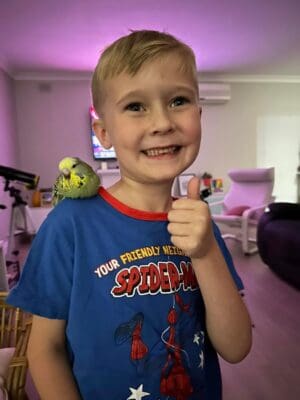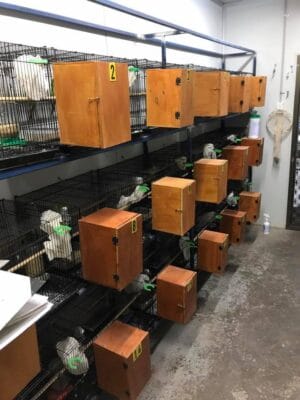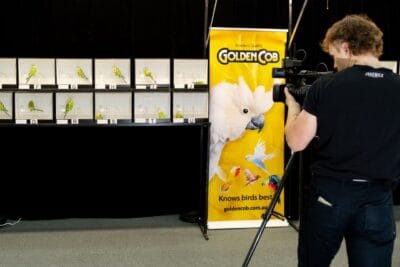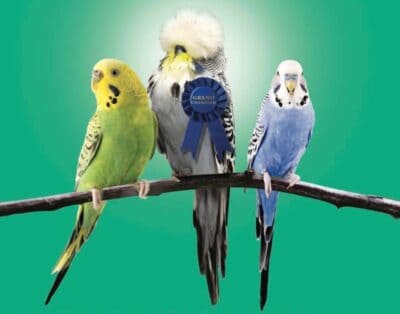
Budgie Bird – Budgies
Budgie Bird – Your Complete Guide to Budgies
Welcome to the Budgerigar Council of South Australia‘s ultimate guide on pet budgie birds, or budgerigars, one of the most popular pet birds worldwide. Whether you’re a first-time bird owner or a seasoned avian enthusiast, our comprehensive budgies guide will provide you with all the information you need about these endearing and vibrant pets. The budgie bird, or budgerigar, is a beloved companion that holds a prominent place in the pet world. Ranking just behind dogs and cats in popularity, this affectionate and cute bird has captured the hearts of many owners. With proper training, budgies can mimic human speech, adding to their appeal. If you’re considering bringing a budgie bird home, it’s essential to familiarise yourself with some facts about these delightful creatures. Let the BCSA help you make an informed choice when it comes to your pet.
Budgie Birds – An Introduction to Budgies
Originating from the wilds of Australia, budgie birds, often simply called budgies or parakeets, have won hearts worldwide with their vibrant colors, sociable nature, and interactive abilities. If you’re considering bringing one into your home, you’re embarking on a rewarding journey of companionship. While some refer to budgies by their formal name, budgerigars, others know them as shell parakeets. However, it’s important to note that while budgies fall under the category of parakeets, there are various types of parakeets available, differing in colors, shapes, and sizes. For instance, Indian ringneck parakeets can reach 16 inches from head to tail, making them significantly larger than the budgie. Therefore, it is more accurate to refer to these birds by their true name, budgerigar.
Although budgies are not the smallest parrots (that title belongs to the parrotlet), they are still quite diminutive. In captivity, most budgies measure between 7 and 8 inches from beak to tail tip. Wild budgies in their native Australian habitat are even smaller.

What Characteristics Do Budgie Birds Have?
Budgie birds are small in size, boast striking colors, and playful personalities. Budgies come in a variety of color mutations and can live up to 10-15 years with proper care. They are also highly intelligent and capable of learning a large vocabulary of human words.
Budgies stand out as an economical and space-efficient pet option, especially when compared to more traditional pets like cats or dogs. Their minimal space requirements make them an ideal choice for families residing in smaller homes or rental properties where larger pets may not be practical. Moreover, the financial aspect of maintaining a budgie is remarkably low, offering a budget-friendly alternative for families. While options like goldfish might win in terms of cost-effectiveness and minimal space requirements, the common Australian budgie stands out as a superior choice for an interactive and engaging pet experience. Offering both affordability and interactivity, budgies carve out a unique niche for themselves as delightful companions.

How Do You Care for Budgies?
Quality care is essential for your budgie bird’s health and happiness. From choosing the right cage and maintaining a balanced diet to providing mental stimulation and routine veterinary check-ups, the BCSA will help you navigate all aspects of budgie care. While budgies are small birds, they need ample space to move and fly. To that end, choose a large, sturdy cage with horizontal bars that encourage climbing. Regular out-of-cage time in a secure environment is also beneficial for their physical and mental health. Furthermore, budgies are intelligent birds and require mental stimulation. Provide a variety of toys and rotate them regularly to keep your budgie’s environment engaging. Interaction with their human family members is also important for their social well-being.
What Do You Feed Budgies?
A balanced diet for your budgie should include a mix of high quality seeds, millet sprays, and vegetables. To that end, variety is key to ensuring your budgie receives all the necessary nutrients. Therefore, providing them with fresh and clean seeds becomes crucial, not only for a successful breeding season but also for their overall well-being.
Spoiled seed is a leading cause of poor breeding outcomes and recurring illnesses in budgerigar aviaries. When “bad feed” is the root problem, it becomes nearly impossible to rectify illnesses and poor breeding results. The root cause of poor quality can be seed age, dirtiness, improper storage, failure to sprout, or high moisture content. Equally pivotal in budgerigar nutrition is the provision of clean water. The water dish can become a breeding ground for illnesses, spreading them to other members of the flock. The sludge that accumulates in the edges and corners of the drinkers is a significant source of dangerous germs.
How Do You Breed Budgie Birds?
Breeding budgies can be a rewarding experience. However, it requires time and resources to ensure the health and wellbeing of both the parent birds and their chicks. Setting up an ideal breeding environment for budgerigars is a critical factor in their successful reproduction. This involves not only choosing the right breeding cage or box but also ensuring it offers ample space, safe nesting materials, and for easy access for cleaning and observation. The breeding process of budgies featured several stages – courtship, mating, egg-laying, incubation, and eventually, the rearing of chicks. Gaining a thorough understanding of each phase and knowing how to support your budgies through these stages is crucial for successful breeding outcomes.

How Can I Train My Budgies & Birds?
With patience and consistency, budgie birds can train to perform various tasks, from simple tricks to mimicking human speech. Our guide will provide you with easy to follow instructions to make training fun for both you and your budgie. While it’s impossible to guarantee that any parrot will learn to mimic speech, budgies display a remarkable aptitude for it. In fact, they often surpass larger parrot species, such as macaws and cockatoos, in terms of clarity and vocabulary. Though their voices may sound gravelly, budgies can grasp words and phrases, occasionally even using them in proper context. For those new to bird ownership seeking a talking parrot, budgies make an excellent choice.
Conclusion
Budgie birds are wonderful companions that bring joy and color to your home. Furthermore, understanding their needs and providing them with care will ensure a happy and healthy life for these charming birds. To that end, we hope this guide serves as a valuable resource for all pet budgie bird owners and fanciers.
For information about budgie birds, buggie birds, or put more correctly, budgie birds, explore our other articles. To that end, make sure you visit our latest News, Sales and Facebook page!




